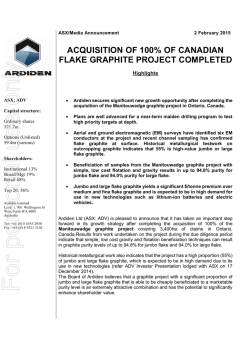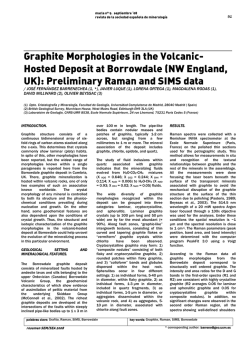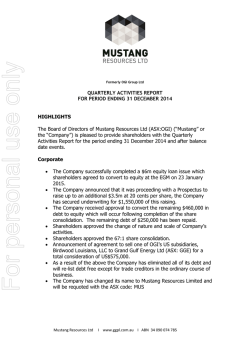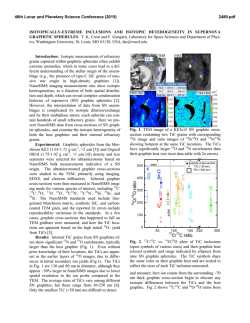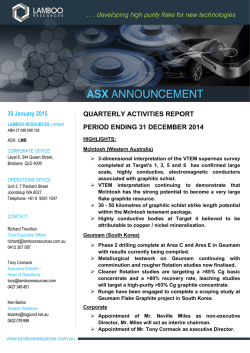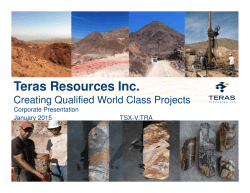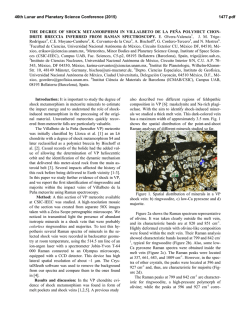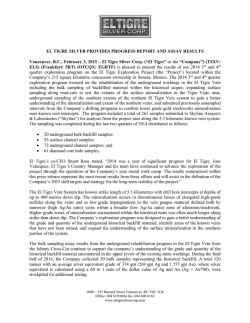
Quarterly Activities Report
30 January 2015 MRL Corporation Limited ACN 007 870 760 ABN 50 007 870 760 Registered Office Suite 3 9 Hampden Road Nedlands WA 6009 Tel +61 1300 660 448 Fax +61 1300 855 044 Directors Craig McGuckin Peter Youd Denis Geldard Peter Hepburn-Brown Joel Chong December Quarterly Report Highly successful Quarter puts MRL on track for graphite production by September Quarter, 2015 MRL (ASX: MRF) is pleased to report on what has been an extremely successful December Quarter for the Company. As a result of this significant progress, MRL is on track to begin production of high-grade graphite from its Aluketiya project in Sri Lanka in the September Quarter, 2015. The key areas of activity during the Quarter were: • Continuing the rehabilitation process of the EL228 – S2 shaft at the Pandeniya graphite project in Sri Lanka. This work was aimed at enabling further bulk samples and, potentially, early production to commence following the conversion to a mining licence. Bulk samples were taken and dispatched for testing. The rehabilitation activities will continue concurrently with the licence conversion process, which is underway. • Continuation of drilling campaign under the main Bopitiya Pandeniya priority area. This is designed to intersect multiple vein sets. DHE228-02 was completed to 262m from a planned total depth of 380m and DHE228-03 was completed to 250m with a planned total depth of 350m. Both these holes will be completed when a larger capacity rig arrives. • A full review of available technical geological data at Aluketiya, including testing core from drilled holes. This was completed successfully. Commenced ground works towards the rehabilitation of selected shafts. A drill rig is currently on site and will commence a further diamond core drilling program in January. • Further exploration work towards drill targets on the Pujapitiya project areas. Initial land access agreements have been negotiated and initial drill targets are ready to be drilled when the rig becomes available. Company Secretary Peter Youd Email: [email protected] Website: www.mrltd.com.au ASX Symbol MRF, MRFOA • • Further geological reconnaissance, mapping and geophysics on the Company’s other priority areas including Dedigama and Hikkaduwa. Initial land access agreements have been negotiated and initial drill targets are ready to be drilled when the rig becomes available. Complete initial analytical testing by Wuhan University in China and Nagrom Metallurgical group for upgrading graphite to battery grade specifications. Pandeniya As planned, the rehabilitation of EL228 – S2 progressed during the period. Civil works have been completed and a head frame has now been constructed. Entry to the shaft will commence during February. On 1st January 2015, an application was lodged with the Geological Mines & Survey Bureau (GSMB) for a portion of EL228 surrounding the Padeniya shaft to be converted to an Industrial Mining Licence. This application and a subsequent MRL presentation at GSMB’s offices were well received and are progressing. EL228-S2 Headframe under construction Schematic of EL228-S2 Headframe EL228-S2 Headframe under construction Aluketiya An Industrial Mining Licence was issued to the Company on 7 November 2014 covering the Aluketiya project in southern Sri Lanka. As advised in a release on 27 January 2015, assays from drilling at Aluketiya returned Total Graphitic Carbon (TGC) grades of up to 99.3%. MRL also advised that rehabilitation and construction work on two historic shafts at Aluketiya is set to commence in March and take approximately two months to complete. Additionally, a diamond drill rig is on site and is commencing a three-hole program with the aim of establishing the presence of further graphite mineralisation and sterilising other areas. Shaft “D” House Shaft “A” Shaft “H” Aluketiya Site looking north Pujapatiya As planned, field work was undertaken on areas within Grid 4 of EL 262 at Pujapatiya – Mornakanda project area. This work included field mapping and trenching samples. Veins were intersected in a number of trenches but basement rock was not intersected. Although graphite samples are contaminated due to vein deposition in unconsolidated material, they still returned a 77.5% TGC result, which is highly encouraging and grades greater than 90% TGC are expected from basement contact (~10m deep). Further drilling is planned on the Mornakanda location to intersect veins down-dip. Mapping has identified six priority areas within Grid 4, EL262 where historical workings were identified. These will be used to plan the drilling for this area in the second quarter of calendar 2015 at the Mornakanda location. As this priority area in Grid 4 is only 1 of 18 grids in the Pupapitiya area, many other priority areas are expected to be located with further mapping. Exploration activities are dictated by land access agreements being in place. This is an ongoing task and MRL has employed another senior Sri Lankan to assist the General Manager in undertaking these duties. This will allow further areas to be opened up for exploration and potential development. Metallurgical Test Work Test work was conducted at Nagrom in Perth and Wuhan University of Technology (WUT) in China during the quarter. As advised in a release on 21 January 2015, the Company received a significant boost to its strategy to become a lucrative battery quality graphite producer, with key metallurgical test work showing its graphite exceeds the grades required for use in lithium ion battery anodes. Testing conducted at WUT found graphite from MRL’s Aluketiya project in Sri Lanka contained 99.98% Total Graphitic Carbon (TGC). Testing is ongoing with a view to simplifying the metallurgical flow sheet and achieving grade of at least 99.95% TGC though acid leaching techniques. MRL Managing Director Craig McGuckin said it had been a significant quarter in the Company’s steady march towards production. “The December Quarter has seen significant progress, with the acquisition of an Industrial Mining Licence and commencement of head frame construction as the Company continues toward its strategic target of being a producer of high-grade Sri Lankan graphite in the foreseeable future,” Mr McGuckin said. The March Quarter MRL is now immersed in an active March Quarter, which includes: • Completing the construction of the Pandeniya EL228 – S2 headframe and installation of the support equipment to enable underground access. The Company also expects to receive its Industrial Mining Licence for this project. • Commencing diamond core drilling at Aluketiya and starting the refurbishment of two shafts in the project area and construction of civil works and headframes. • Further exploration work towards drill targets on the Pujapatiya project areas including further Land Access agreements. • Further analytical testing by Wuhan University in China and Nagrom Metallurgical group to simplify the metallurgical flow sheet and achieve grade of at least 99.95% TGC though acid leaching techniques. • Receipt of approvals form the Board of Investment of Sri Lanka on the Company’s Aluketiya project which will provide import and VAT concessions. • Discussions with potential offtake parties for planned production. About MRL Corporation Ltd (ASX: MRF) MRL is aiming to develop an underground mining operation to extract high-grade, crystalline vein graphite, which is unique to Sri Lanka. The Company holds exclusive rights to exploration licenses covering approximately 6,300 hectares in area, with historical workings located within nearly all license grids. For further information: About Graphite Managing Director Natural graphite occurs in three forms: amorphous graphite, flake graphite and the most rare and highest quality form being crystalline vein graphite. Sri Lanka is famed for being the only commercial producer of crystalline vein graphite (lump or Ceylon graphite), the highest quality of naturally occurring material in the world. The quality of vein graphite produced in the country has a purity level in excess of 90% TGC (Carbon as graphite) which means little upgrading and processing is required to make a high quality saleable product. Amorphous (micro crystalline) graphite is the least pure form of naturally occurring graphite and commercial deposits usually have a carbon content of 70-85%, and are found as lenses or lumps with flat fracture cleavages. It is normally formed by metamorphism of previously existing anthracite coal seams. Flake (crystalline) graphite is the more common form of graphite and typically has carbon content in the range of 80-99%, and is usually formed in metamorphic rock in concentrations of 5%-12% of the ore body. Mining and processing of these deposits is similar to open pit gold or copper mines, requiring ‘large scale’ mining and processing to extract the graphite. Large-scale mining and processing plants typically equates to high capital expenditures and relatively high operating costs. Vein (crystalline) graphite is the purest form of graphite with TGC grades typically >90%, with some grade as high as 99.5% TGC. Mining vein graphite may be considered analogous to high-grade gold vein mining, requiring considerably less capital expenditure when compared to large-scale open pit mining. That is, development, mining equipment and processing plants will be of a significantly smaller scale. Operating unit costs will also be lower than those for typical large-scale open pit mining. Nature of vein graphite Sri Lankan graphite deposition model is best described from the ‘bottom up’: tension fractures formed in the metamorphic sediments, caused by the folding of the sediments, creating ‘conduits’ for the hydrothermal deposition of high quality vein graphite. Historically, mining of these veins has found the veins generally increase in thickness and ° grade quality with increasing depth. Graphite veins generally dip steeply at –70 to near vertical, enabling ‘narrow vein’ extraction mining techniques similar to those used on narrow vein, high-grade gold deposits. The method commonly used is an overhead retreat stoping technique where the high-grade vein graphite is mined and hauled to surface without contamination. The graphite selvages, in contact with the surrounding waste, is hauled to surface and stockpiled for upgrading. The balance of the waste is used to fill the floor of the stope. Due to the nature of the vein graphite, it is anticipated vein widths of ~25cm, using narrow vein mining techniques can be economically extracted from underground operations. Craig McGuckin MRL Corporation Ltd Peter Youd Executive Director MRL Corporation Ltd www.mrltd.com.au Information in this report relating to Metallurgical interpretation, analysis, mineral distribution and recommendations has been compiled by Mr Denis Geldard, MAusIMM in consultation with Dr Slobodanka Vukcevic, Senior Metallurgist at Nagrom the Mineral Processors. Dr Slobodanka Vukcevic has sufficient experience and expertise relevant to this type of test work through her job experience and expertise and qualifies as a competent person in the field of metallurgy. Mr Geldard consents to the inclusion in the report of the matters based on the information reported in the form and context in which it appears. Information in this report relating to Exploration Results is based on information compiled by Mr Denis Geldard, MAusIMM working in consultation with consulting Geologist Mr Gary Powell, MAusIMM and MRL’s Senior Sri Lankan Geologist who has 35 years of vein graphite experience in Sri Lanka. Their experience is relevant to the type of deposit under consideration. Mr Geldard is signing as competent person as defined in the 2012 Edition of the “Australasian Code for Reporting of Exploration Results, Mineral Resources and Ore Reserves. Mr Geldard consents to the inclusion in the report of the matters based on the information in the form and context in which it appears. JORC TABLE 1 Report for Exploration Locations Section 1 Sampling Techniques and Data Criteria Sampling techniques Explanation Diamond core is collected and stored in core trays of 5m per tray. Vein graphite is readily identified visually (black in colour) and intersections recorded accordingly. Intersections will then be cut under the supervision of MRL’s Senior Sri Lankan Geologist and prepared for transport to Nagrom (Australia) for analysis. Drilling techniques All future drilling will be undertaken utilising NQ Triple Tube (NQTT) drilling. Drill sample recovery Diamond core recovery is recorded between core runs by the geological crew in the Core Logging Record. The unconsolidated surface material will be drilled using rotary wash method until competent material is intersected Logging All holes are logged on site by MRL geological personnel under the supervision of MRL’s Senior Sri Lankan Geologist, using MRL’s Core Logging Procedure Manual. Logging will record geological and geotechnical observations, and is undertaken on a continual basis throughout the entire drill hole. Sub-sampling techniques and sample preparation Half-core intersections of Vein Graphite will be submitted for analysis to Nagrom laboratories in Perth Western Australia. The remaining half-core is stored in the core boxes. Core & bulk samples may be provided to potential off-take parties. Quality of assay data and laboratory tests All Vein Graphite core intersections will be analysed by Nagrom the Mineral Processors in Perth Western Australia and or Wuhan University of Technology (WUT). Nagrom and WUT will follow industry practice QA/QC procedures to ensure high quality sample assurance. Certified Sample Standards will be inserted routinely into sample analysis. Verification of sampling and assaying All diamond core will be logged and photographed by MRL geologists under the supervision of MRL’s Senior Sri Lankan Geologist. Independent consulting geologist will visit the MRL operation sites on a regular basis to oversee QA. Location of data points All drill locations have been positioned using hand-held Garmin GPS systems. MRL has completed a full topographical survey of the Pandeniya – Bopitiya & Aluketiya areas. All drill collars will be geo-referenced to the Sri Lankan Transverse Mercator Projection. Data spacing and distribution Drill holes have been orientated in a position to intersect the expected vein mineralisation (based on historical shafts / adits and geophysical information) at the optimal angle for evaluation, whilst minimising surface land disturbance. Orientation of data in relation to geological structure Diamond Core Drill holes are designed to intersect potential graphite vein mineralisation perpendicular to strike, wherever possible, whilst taking into account expected deviation in dip and azimuth. Sample security Core Samples are collected and stored in core trays under the supervision of MRL geological crews and then transported at the end of each day, and secured in a locked container at the MRL site facility for further detailed logging. Security is managed by MRL’s Senior Sri Lankan Geologist and the MRL country General Manager. Criteria Audits or reviews Explanation A review was undertaken by the consulting Geologist of all procedures, including retrieving of core samples from the core tube, through to logging and storage of core samples, during drilling activities. Consulting Geologist will undertake further reviews into the future. Section 2 Reporting of Exploration Results Criteria Mineral tenement and land tenure status Explanation The Warakapola / Bopitiya / Pandeniya project exploration license areas EL228 are 100% owned by MRL Graphite (Pvt) Ltd. The exploration Licenses when granted have a two year term which can be renewed prior to the 2 year anniversary. License No. EL/225 EL/226 EL/227 EL/228 EL/231 EL/243 EL/244 EL/262 Exploration done by other parties Geology Drill hole Information MRL Interest 100% 100% 100% 100% 100% 100% 100% 100% Status Granted Granted Granted Granted Granted Granted Granted Granted General Location Central Central South Central Central South West Central South West Central IML/C/HO/8416 100% Granted Western MRL Corporation Ltd has informed the Consulting Geologist all granted licenses are in good standing and comply with the reporting requirements of the exploration licence. Initial Exploration and Review of the Warakapola / Bopitiya / Pandeniya project was carried out by Geological Survey and Mines Bureau (GSMB) Technical Services (Pvt) Ltd with reports provided to MRL. MRL has established a regional office in the EL228 area to support the company geologists and underground exploration crews. Historical mining has taken place with several shafts and adits evident. MRL is undertaking mapping in other license areas Warakapola / Bopitiya / Pandeniya / Aluketiya Geologically, the area covered by the selected grid units belong to the Wanni Complex of Sri Lanka. The Wanni Complex is mainly characterised by thick sequences of orthogneisses, comprising amphibolite, migmatitic, granitic and granodioritic gneisses. These rocks represent a series of antiformal and synformal structures. A characteristic feature of the exploration area is the alignment of identified abandoned graphite mines / pits within a NNW-SSE trending corridor,.(GSMB 2013) Planned Diamond Core Drill Holes Drill Hole Easting Northing Dip / Hole Comments Azimuth Depth AK07 134,584 136,467 65 °/ 325° 150m AK08 134,540 136,606 50 °/ 338° 160m AK09 134,642 136,515 50 °/ 325° 110m All Diamond Core Drill holes are planned to be accurately surveyed for dip and azimuth using a GlobalTech Pathfinder multi-shot, electronic, down-hole survey tool. A GlobalTech core orientation tool is being used to orientate the core during the drilling. Data aggregation methods Intersections of diamond core containing vein graphite will be visually selected for analytical testing with accurate lengths recorded to ensure 100% of mineralisation is analysed and reported. Relationship between mineralisation widths and intercept lengths Planned Drill hole orientation is based on observations from historical shafts / adits and geophysics, and planned to intersect any vein graphite mineralisation as close to perpendicular as practical. Diagrams Refer Figure 1 Pujapitiya EL262 Grid 4 priority locations. Balanced reporting MRL Corporation Ltd will endeavour to produce balanced reports accurately detailing the results from any exploration activities. Other substantive exploration data Further work No other substantive exploration data is available at this time. MRL Corporation Ltd continues to complete further site investigations on its other licenses. Following the completion of progressive site investigations and evaluation the next phase of exploration for each location will be undertaken and reported. Land access agreements continue at Pujapitiya, Dedigama and Hikkaduwa Further drilling is planned at Aluketiya, Pujipatia and other license areas as land access is obtained.
© Copyright 2025
